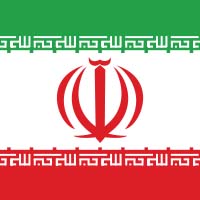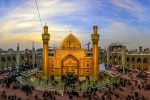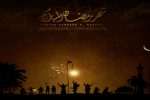The Tenth Holy Imam Imam Ali un-Naqi al-Hadi (A.S.)
Imamat:The Tenth Holy Imam(A.S.) like his father , was also elevated to the rank of Imam in his childhood . He was six years old when his father Imam Muhammad al – Jawad was martyred. Imam Tortured by Abbasid Caliphs:After the death of al – Ma’mun , al – Mu`tasim succeeded him , and was […]

Imamat:
The Tenth Holy Imam(A.S.) like his father , was also elevated to the rank of Imam in his childhood . He was six years old when his father Imam Muhammad al – Jawad was martyred.
Imam Tortured by Abbasid Caliphs:
After the death of al – Ma’mun , al – Mu`tasim succeeded him , and was later followed by the caliph al – Wathiq . In the first five years of the reign of al – Wathiq , Imam Ali al – Hadi ( an – Naqi ) lived peacefully . After al – Wathiq , al – Mutawakkil came to power . Being too occupied in State affairs , al – Mutawakkil did not get any time to harass the Imam and his followers for four years . But as soon as he freed himself from State affairs , he started to molest the Imam . The Holy Imam devoted himself to the sacred mission of preaching in Medina and did thus earn the faith of the people as well as their allegiance and recognition of his great knowledge and attributes . This reputation of the Imam evored the jealousy and malice of al – Mutawakkil against him.
The governor of Medina wrote to al – Mutawakkil that Imam `Ali al – Hadi had been manoeuvring a coup against the government and a multitude of Shi’ites were pledged to his support . Although enraged by this news al – Mutawakkil still preferred the diplomacy of not arresting the Holy Imam. Under the garb of pretended respect and love towards the Imam , he planned to put him under life imporisonment after inviting him to his palace. Prior to his imprisonment , in a series of correspondence with the Imam, he expressed the view that he was convinced of all the claims of the Imam and was ready to settle them amicably . He wrote to the Imam that having been acquainted with his great personality , his matchless knowledge and his peerless attributes , he was impatiently looking forward to the honour of seeing him , and he most cordially invited him to Samarra’ .
Imam Prisoned in Samarra
Although the Imam was well aware of al – Mutawakkil’s treacherous intentions , he anticipating the fatal consequences of refusing the offer , reluctantly decided to leave Medina . But when the Imam arrived at Samarra’ and al – Mutawakkil was informed about it , he took no notice of the Imam’s arrival. when asked about where the Imam should stay , he ordered that the Imam should be put up in the inn meant for beggars , destitutes and homeless people.
Al-Mutawakkil who was a deadly enemy of the Ahlul-Bayt , removed the Imam from this inn and entrusted him to the custody of a stone – hearted brute named Zurafah . But , by the grace of Allah , his enmity was , in a short time , transformed into love and devotion for the Imam . When al – Mutawakkil learnt about it , he shifted the Imam into the custody of another cruel man called Sa’id . The Imam remained under his strict vigilance for a number of years , during which he was subjected to boundless tortures .
But even in this miserable imprisonment , the Imam kept devoting himself at all times to the worship of Allah . The watchman of the prison used to comment that Imam `Ali al – Hadi seemed to be an angel in human garb. When Fath ibn Khaqan became the vizier of al – Mutawakkil , he being a Shi`ah could not stand the idea of the Imam’s captivity . He endeavoured to have him released from imprisonment and arranged for his comfortable residence in a personally purchased house at Samaraa’ .
Historical Event:
Still al – Mutawakkil could hardly refrain from his antagonism to the Imam and he appointed spies to watch the Imam and his connections . But through all these attempts , his hope of creating some fabrication to prove the Imam’s activity against himself could not be realized. In the time of al – Mutawakkil there was a woman named Zaynab who claimed to be a decendant of Imam Husayn . al – Mutawakkil sought the confirmation of Zaynab’s claim from the Imam and said : “That as the beasts are prohibited to eat the flesh of the descendants of Imam Husayn he would throw Zaynab to the beasts and test her claim .” On hearing this , Zaynab began to tremble and confessed that she was a fake . al – Mutawakkil then ordered the Imam to be thrown to the beasts to test the claim . To his great surprise , he witnessed the beasts prostrating their heads before the Imam.
Once al – Mutawakkil happened to suffer from a serious malady which was eventually declared incurable by his physicians . When the Imam was approached for some remedy , he prescribed an application which resulted in a spontaneous cure. Once al – Mutawakkil was informed that the Imam was preparing a revolt against him . Thereupon , he ordered a detachment of the army to launch a raid on the Imam’s residence . When the soldiers entered his house , they found him sitting on a mat , reciting the Holy Qur’an.
Imam Martyred
Not only al – Mutawakkil , but his successors’ opposition to the Imam was fierce . After the death of al – Mutawakkil , al – Mustansir , al – Musta`in and al – Mu`tazz carried on the same mission of harassent against the family of the Imam. al – Mu`tazz , understanding the uncontrollable and intense devotion of the people towards the Imam , eventually contrived the Imam’s assassination. He got him poisoned through an ambassador which resulted in the Imam’s death within a few hours . The martyrdom occurred on 3rd Rajab 254 AH , and his funeral prayer was conducted by his son , Imam Hasan al – `Askari . The Imam was only forty – two years old at the time of martyrdom . The period of his Imamate was thirty – five years . He was buried in Sammarra’ Iraq.
Imam Hadi(A.S.) Sayings:
Do not expect honesty and purity of intention from someone who has suffered from your malice; do not expect loyalty from one to whom you have been disloyal; do not expect goodwill from someone whom you regard with ill-will: his heart towards you is the same as your heart towards him. Others will fear him who fears Allah.He who obeys Allah will be obeyed.He who obeys Allah will not care for the dissatisfaction of the creatures.He who enrages the Creator should be sure of encountering the dissatisfaction of the creatures. You should present thorough obedience to those who present for you their thorough love and advice. Do not feel secure from those who disgraced their personalities.
He who feels secure from Allah’s unexpected retribution and painful penalty will feel arrogant until Allah’s act and inevitable decree(death) will befall him.He whomever receives evidence from his Lord will belittle the worldly misfortunes even if he is cut into pieces. There are definite places in which Allah likes the servants to supplicate to Him.One of these places is the tomb of Al-Husayn(A.S.),Sayyid ush-Shuhada(Master of the Martyrs).
History of the Holy Shrines of Imam Ali un-Naqi(A.S.) and Imam Hasan al-Askari(A.S). The modern city of Samarra is situated on the bank of the river Tigris some sixty miles from the city of Baghdad. The city is of outstanding importance because of its two shrines. The golden dome on one shrine was presented by Nasr al-Din Shah and completed under Muzaffar al-Din Shah in the year 1905 A.D. Beneath the golden dome are four graves, those of Imam Ali al-Naqi (10th Imam) and his son, Imam Hasan al-Askari (11th Imam). The other two are of Hakimah Khatoon, the sister of Imam Ali al-Naqi who has related at length the circumstances of the birth of Imam al-Mahdi and the fourth grave is of Nargis Khatoon, the mother of Imam al-Mahdi, peace be upon him.
The second shrine marks the place where Imam al-Mahdi went into concealment. It has a dome that is distinguished for the soft delicate design that is worked in blue tiles, and beneath it is the Sardab (cellar) where the Imam is said to have disappeared. Visitors may enter this Sardab by a flight of stairs. In the year A.D. 836, after two years experience with factional strife in Baghdad, the Caliph Mu’tasim departed with his Turkish army to Samarra, “Which he founded and made his residence and military camp.”1 There eight caliphs lived in the short period of fifty-six years.2 The distance of Samarra from Baghdad is sixty miles. This name, Surra man ra’a (He who sees it, rejoices), is said to have been given by Mu’tasim himself, when, for approximately £2,000, he purchased as a site for his new city a garden that had been developed by a Christian monastery.
The Caliph’s happy Arabic pun was based on the Aramaic name, Samarra, which was a town in the immediate vicinity from the times before the Arab conquest. The general district, however, was known as Tirhan.3 Thus the site chosen was an attractive garden spot in a fertile valley of the Tigris, and there the Caliph built his new capital, which became known as “the second city of the Caliphs of the Bani Hashim.”
A main avenue, with many residences, ran along the river bank. In the garden of the monastery he built his royal palace, known as the Daru’l Amma, and the monastery itself became his treasury. A Friday Mosque, was built by Mu’tasim very close to the quarter of the city that was set aside for the army. Mustawfi informs us further that “he built a Minaret for the Mosque. 17=ells (about 19 metres) in height, with a gangway (to ascend it, that went up) outside, and no Minaret after this fashion was ever built by anyone before his time.”4 This Minaret, was so large that a man on horseback is said to be able to ascend its so-called gangway. The same thing is claimed for the similar minaret in the Mosque of Tulun, which may have been modelled after it.5
But the Turkish mercenaries, on whom Mu’tasim and his sons and grandsons relied, soon became the true masters of the situation. While they cherished their position as guardians of the caliphs, whom they permitted to live in luxury and security, nevertheless they so exploited their own opportunities – for gain, through cruelty and oppression, that in matters of internal administration the authority of the Muslim Empire sank to a low ebb. This was at a time, however, according to Dinawari, when there were more victories, for the troops than during any preceding caliphate.6
In Samarra the caliphs busied themselves building palace after palace, on both sides of the river, and at a cost that Yakut estimated as 204 million Dinars, which would not be less than eight million sterling.7 A great cypress tree is celebrated in the Shah Nameh as having sprung from a branch brought by Zoroaster from Paradise. It is said to have stood at the village of Kishmar, near Turshiz, and to have been planted by Zoroaster in memory of the conversion of King Gushtasp to the Magian religion. Such too was its power that earthquakes, which frequently devastated all the neighbouring districts, never did any harm in Kishmar. According to Kazvini, the caliph Mutawakkil in 247 A.H. (861 A.D.) caused this mighty cypress to be felled, and then transported it across all Persia, in places carried on camels, to be used for beams in his new palace at Samarra. This was done inspite of the grief and the protests of all the Guebres, but when the cypress arrived on the banks of the Tigris, Mutawakkil was dead, having been murdered by his son.8
Mustawfi who wrote in the fourteenth century, takes pain to mention with sympathy how the Caliph Mutawakkil enlarged Samarra, and in particular, how “he built a magnificent Kiosk, greater than which never existed in the lands of Iran, and gave it the title of the Ja’fariyyah (his name being Ja’far). But evil fortune brought down on him in that he had laid in ruins the tomb of Imam Husain, at Karbala, and furthermore he had prevented people from making their visitation to the same – decreed. that, shortly after his death, his Kiosk should be demolished, so that no trace of it now remains. Indeed, of Samarra itself, at the present time, only a restricted portion is inhabited.”9
The restricted portion that was still occupied in the fourteenth century was approximately the same as the modern Samarra, and was part of the “Camp of Mu’tasim.” Here the Imams, Ali al-Naqi and his son, Hasan al-Askari were imprisoned and poisoned and hence they were called the Askariyan, or the “Dwellers in the Camp.” It was here also that both of them were buried. The modern Samarra is only a few paces removed from the walls of the old Friday Mosque, which agrees with Mustawfi’s observation that “in front of the mosque stands the tomb of the Imam Ali al-Naqi, grandson of the Imam Ali al-Ridha; and also of his son, the Imam Hasan al-Askari.” That the city of the Caliphs was much more extensive is indicated by the modern observation that “the ground plan of the many barracks, palaces and gardens can be very plainly seen by anyone flying over the site in an aeroplane.”10
The historical topography of the ephemeral capitol of the Caliphs as outlined by the Arab geographers, Ya’kubi and Yakut, has been investigated recently by archaeologists, so that the location of the principal streets and of the many of the palaces has been determined. Also the findings have proved to be of special value to students of Muslim art, for they are representatives of the period when the civilization of the Abbasid caliphate was “shedding its lustre over the world.”11 It was in this part of Samarra that still remains that the Imam Muhammad ibn Hasan al-Askari disappeared from human sight. Mustawfi says this happened in 264 A.H.
(878 A.D.) at Samarra.12 The fact that the Shia community was permitted to have its headquarters after the fall of the Buyids in the nearby city of Hilla, from which place they conducted their negotiations at the time of the invasion of Khulagu Khan, gave rise to the tradition that the Hidden Imam would reappear in that town. This accounts for the confusion of the traveller, Ibn Batuta (A.D. 1355), who found shrines dedicated to the last Imam, both in Hilla and Samarra. The mosque of the last Imam in Hilla marks the place of his expected reappearance, but the place of his disappearance is at Samarra. At Hilla, Ibn Batuta found that the mosque had an extended veil of silk stretched across its entrance, and it was a practice for the people “to come daily, armed to the number of a hundred, to the door of this mosque, bringing with them a beast saddled and bridled. `Come forth, Lord of the Age, for tyranny and baseness now abounds; this then is the time for thy egress, that, by thy means, God may divide between truth and falsehood.’ They wait till night and then return to their homes.” Samarra itself was at that time in ruins, though Ibn Batuta mentions that “there had been a mashhad in it, dedicated to the last Imam by the Shias.”13
It may have been owing to the fact that the place was in ruins that pains were not taken to ascertain that the mashhad was the “place of witness” in memory of the Imams, Ali al-Naqi and Hasan al-Askari, and that a different spot nearby was highly regarded as the place where the last Imam disappeared.14
Footnotes:
1. Dinawari, Akhbar at-Tiwal, et. Guirgass, p. 396.
2. Ya’kubi (A.D. 891), Kitab al-Buldan, cd. de Goeje, p. 255, & Mustawfi, Nuzhatu’l-Qulab, Eng. trans. Le Strange, p. 40.
3. Ya’kubi, op. cit., p. 255; and Le Strange, Lands of the Eastern Caliphate, pp. 53-54.
4. Mustawfi, op. cit., p. 49.
5. Encyclopaedia Britannica, 11th edit., Vol. II, p. 424.
6. Dinawari, op., cit, 396.
7. Le Strange, op., cit., p. 55.
8. Ibid., p. 355.
9. Mustawfi, op. Cit., p. 49.
10. Historical Mesopotamia, A Guide Book published by Baghdad Times, Baghdad, 1922, p. 51.
11. Ency. Islam, art. “Samarra”, with references to the investigations of E. Herzfeld.
12. Mustawfi, op. cit., p. 47.
13. The reference is to the Rawafidh. Sayyid Murtada remarks in the Alamul Huda (ch. XIX), “The second division of Islam call themselves `the followers’, the Shias,
but their adversaries call them `the abandoners’ the Rawafidh.” For a full discussion of this name, see article by Dr. Freidlander, J.A.O.S. Vol. XXIX, p. 137-159.
14. Ibn Batuta, cd. Paris, ii, p. 98; ibid., – trans. Lee, ch. VIII, p. 48; De Herbelot, Ann. Mosl., tom. iii, p. 716 and the Encyclopaedia of Religion and Ethics, art. “Mahdi”, vol. III, p. 338.
این مطلب بدون برچسب می باشد.










Leave a Reply